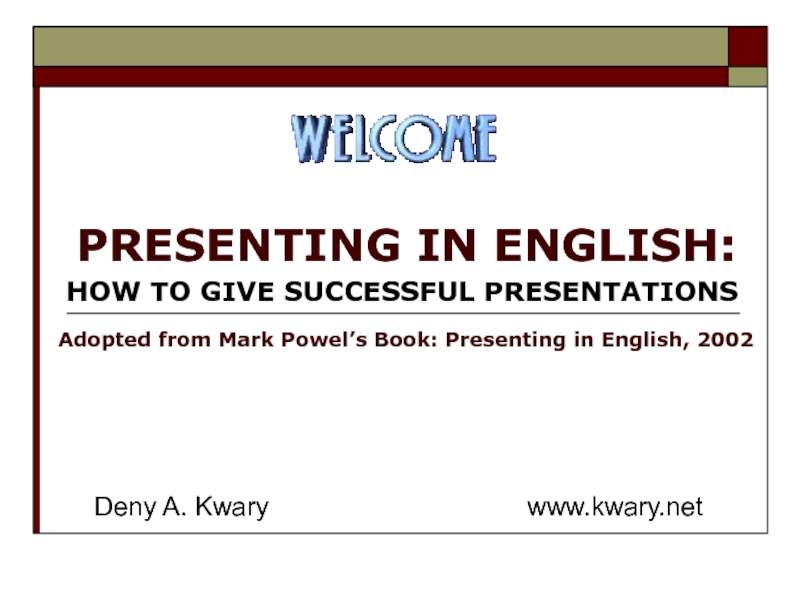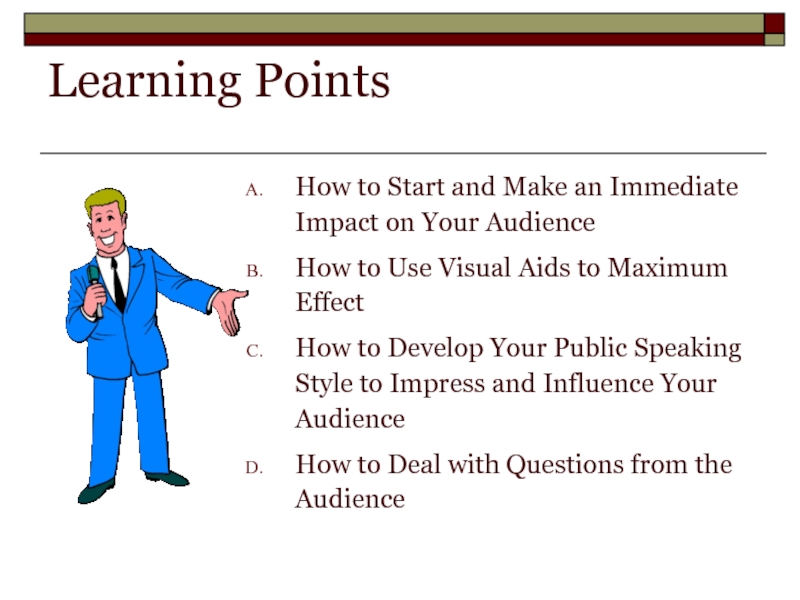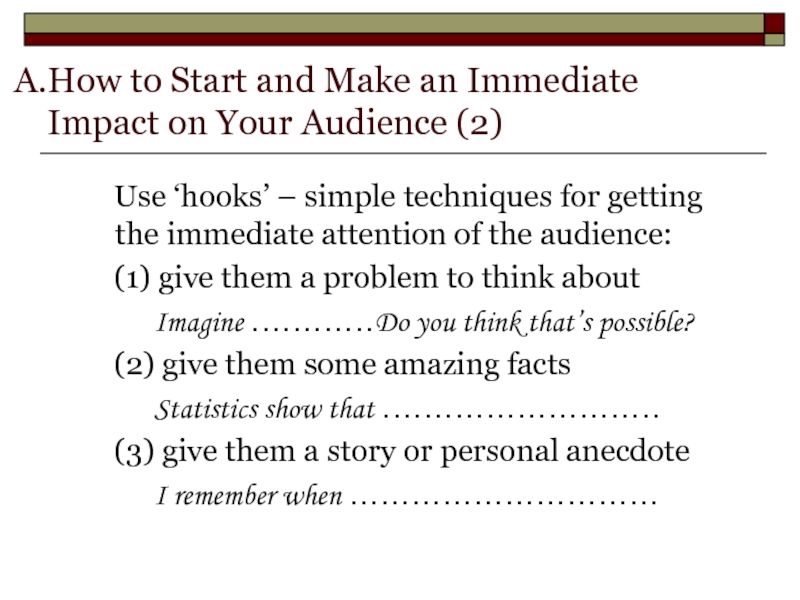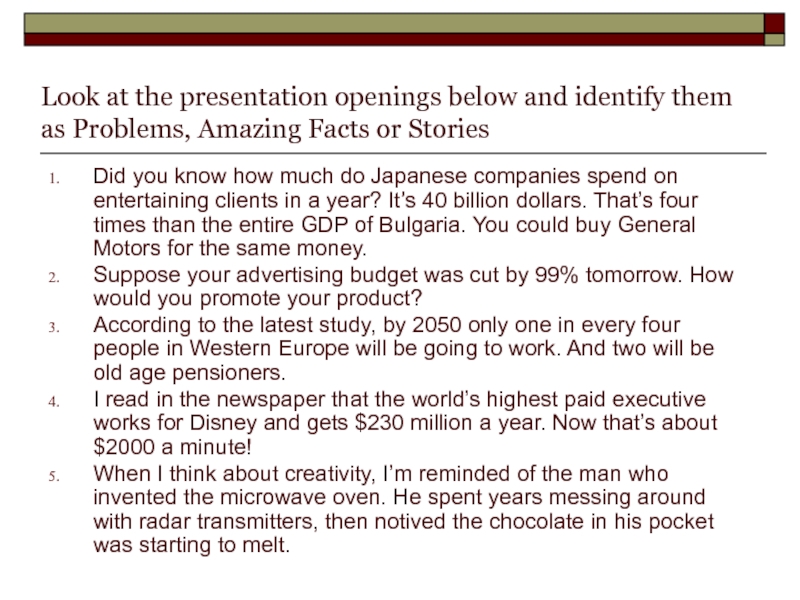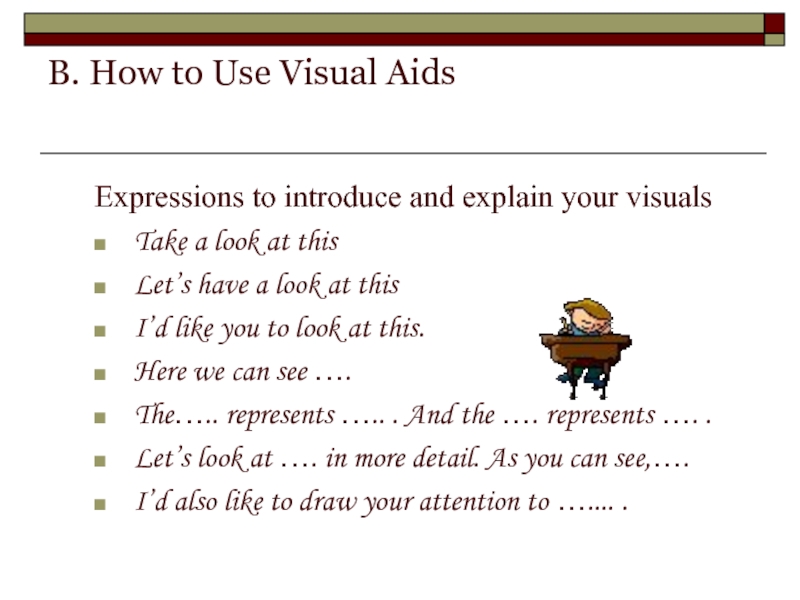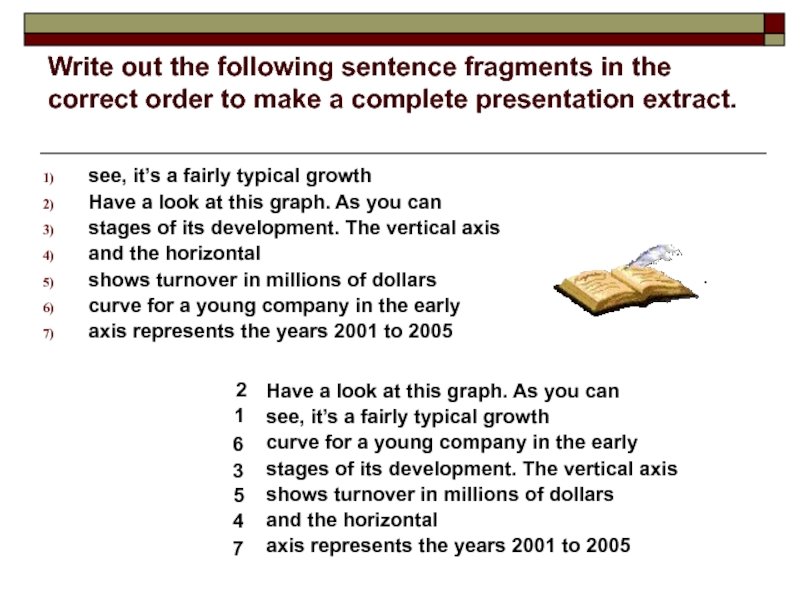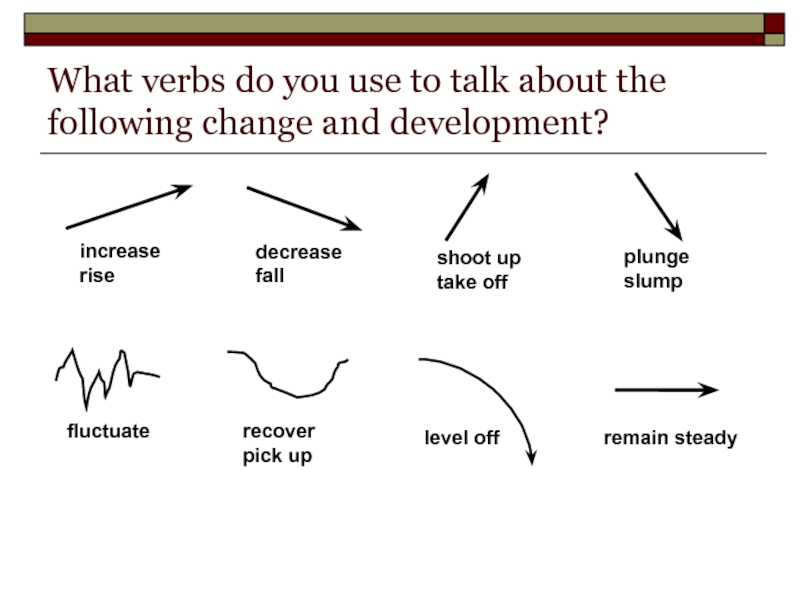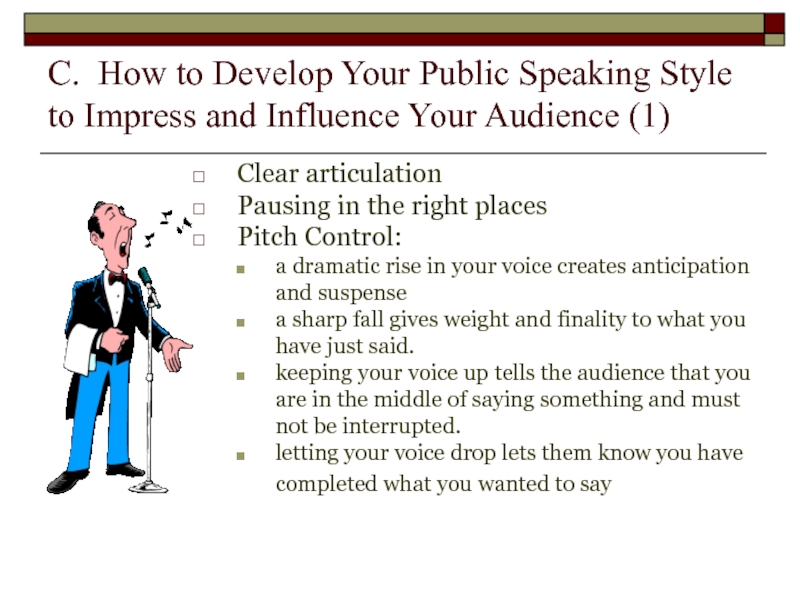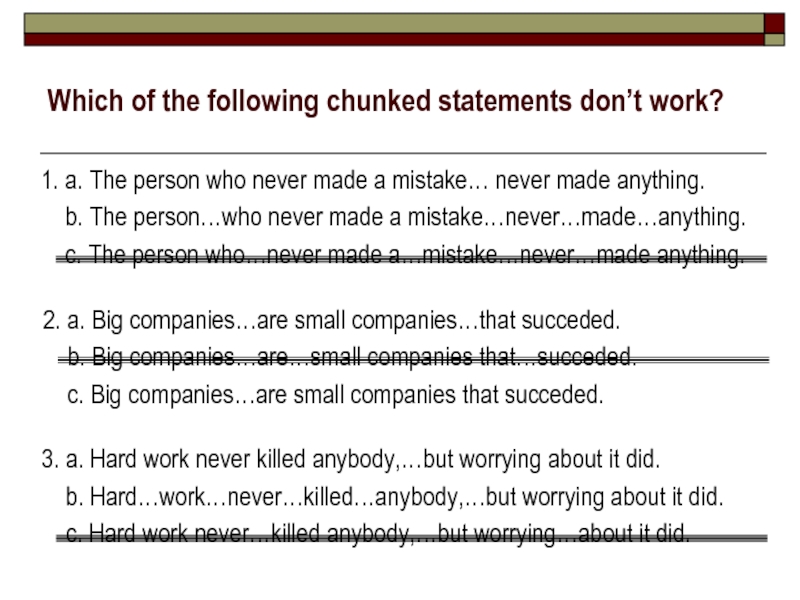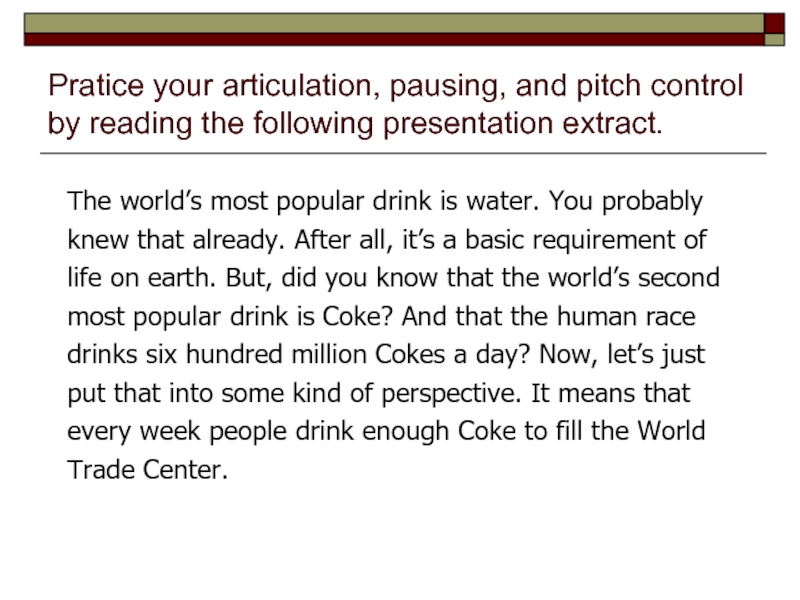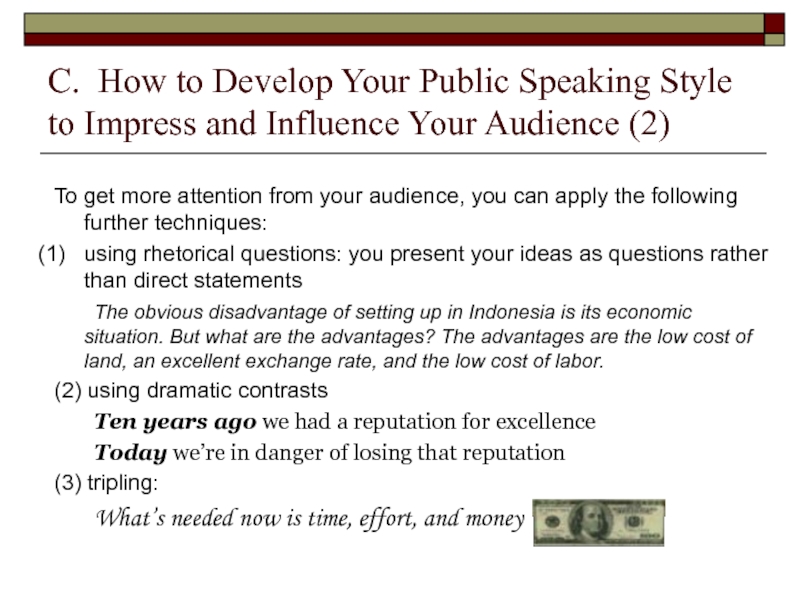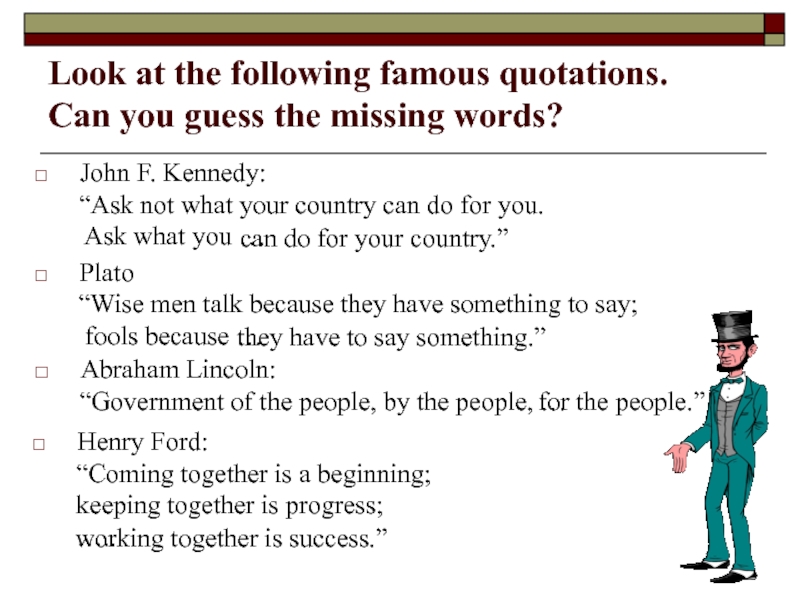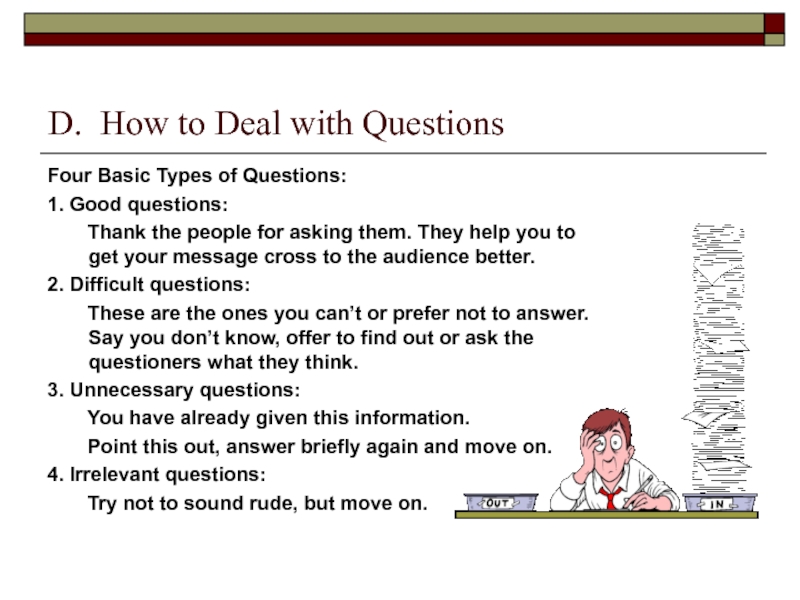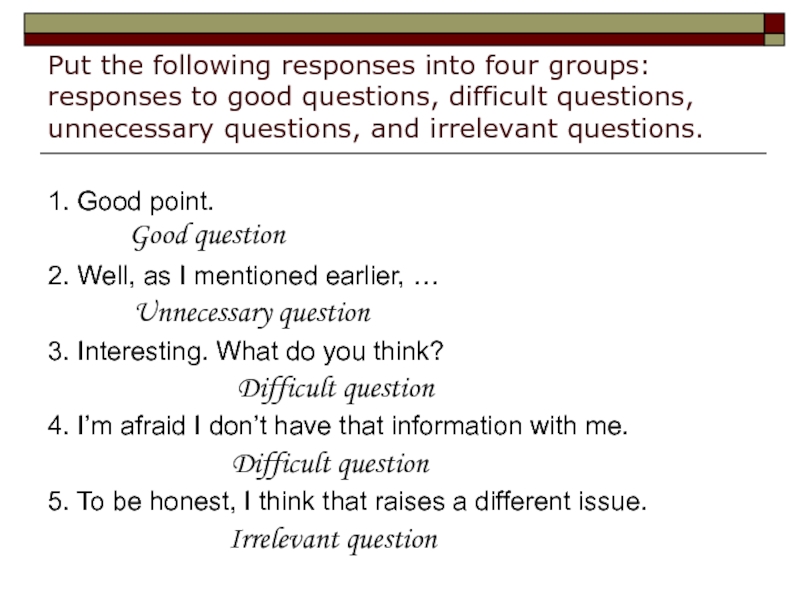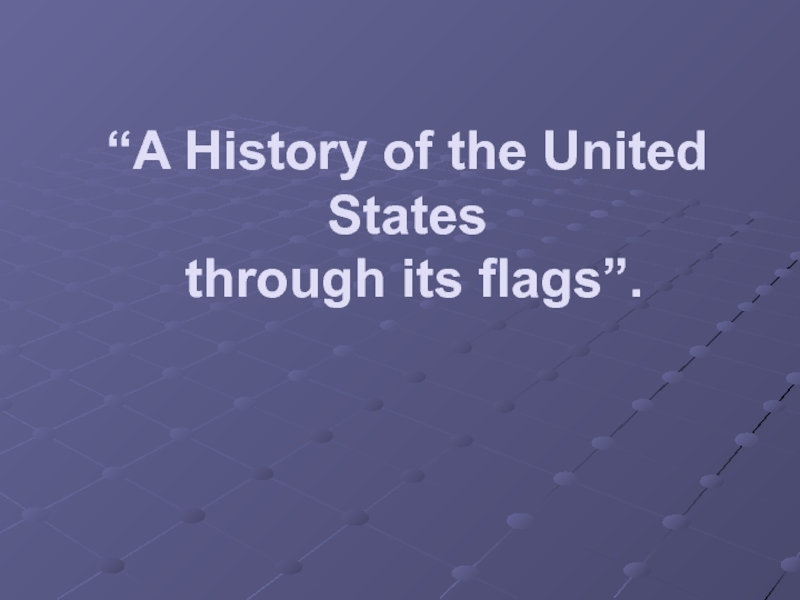Adopted from Mark Powel’s Book: Presenting in English, 2002
- Главная
- Разное
- Дизайн
- Бизнес и предпринимательство
- Аналитика
- Образование
- Развлечения
- Красота и здоровье
- Финансы
- Государство
- Путешествия
- Спорт
- Недвижимость
- Армия
- Графика
- Культурология
- Еда и кулинария
- Лингвистика
- Английский язык
- Астрономия
- Алгебра
- Биология
- География
- Детские презентации
- Информатика
- История
- Литература
- Маркетинг
- Математика
- Медицина
- Менеджмент
- Музыка
- МХК
- Немецкий язык
- ОБЖ
- Обществознание
- Окружающий мир
- Педагогика
- Русский язык
- Технология
- Физика
- Философия
- Химия
- Шаблоны, картинки для презентаций
- Экология
- Экономика
- Юриспруденция
Presenting in english: how to give successful presentations презентация
Содержание
- 1. Presenting in english: how to give successful presentations
- 2. Learning Points How to Start and Make
- 3. How to Start and Make an Immediate
- 4. Use ‘hooks’ – simple techniques for getting
- 5. Look at the presentation openings below and
- 6. B. How to Use Visual Aids Expressions
- 7. Write out the following sentence fragments in
- 8. What verbs do you use to talk
- 9. C. How to Develop Your Public Speaking
- 10. Which of the following chunked statements don’t
- 11. Pratice your articulation, pausing, and pitch control
- 12. C. How to Develop Your Public Speaking
- 13. Look at the following famous quotations. Can
- 14. D. How to Deal with Questions Four
- 15. Put the following responses into four groups:
- 16. Now You CAN Start and Make an
- 17. That's All. Thank You for Your Attention. www.kwary.net
Слайд 1PRESENTING IN ENGLISH:
HOW TO GIVE SUCCESSFUL PRESENTATIONS
Deny A. Kwary
Слайд 2Learning Points
How to Start and Make an Immediate Impact on Your
How to Use Visual Aids to Maximum Effect
How to Develop Your Public Speaking Style to Impress and Influence Your Audience
How to Deal with Questions from the Audience
Слайд 3How to Start and Make an Immediate Impact on Your Audience
Good afternoon, ladies and gentlemen.
(On behalf of…, may I welcome you to…)
My name’s …
I’m responsible for/I’m from …
This afternoon I’d like to…
discuss…
report…
and present…
If you have any questions you’d like to ask, I’ll be happy to answer them.
or
Perhaps we can leave any questions you may have until the end of the presentation.
Слайд 4 Use ‘hooks’ – simple techniques for getting the immediate attention of
(1) give them a problem to think about
Imagine …………Do you think that’s possible?
(2) give them some amazing facts
Statistics show that ………………………
(3) give them a story or personal anecdote
I remember when …………………………
How to Start and Make an Immediate Impact on Your Audience (2)
Слайд 5Look at the presentation openings below and identify them as Problems,
Did you know how much do Japanese companies spend on entertaining clients in a year? It’s 40 billion dollars. That’s four times than the entire GDP of Bulgaria. You could buy General Motors for the same money.
Suppose your advertising budget was cut by 99% tomorrow. How would you promote your product?
According to the latest study, by 2050 only one in every four people in Western Europe will be going to work. And two will be old age pensioners.
I read in the newspaper that the world’s highest paid executive works for Disney and gets $230 million a year. Now that’s about $2000 a minute!
When I think about creativity, I’m reminded of the man who invented the microwave oven. He spent years messing around with radar transmitters, then notived the chocolate in his pocket was starting to melt.
Слайд 6B. How to Use Visual Aids
Expressions to introduce and explain your
Take a look at this
Let’s have a look at this
I’d like you to look at this.
Here we can see ….
The….. represents ….. . And the …. represents …. .
Let’s look at …. in more detail. As you can see,….
I’d also like to draw your attention to ….... .
Слайд 7Write out the following sentence fragments in the correct order to
see, it’s a fairly typical growth
Have a look at this graph. As you can
stages of its development. The vertical axis
and the horizontal
shows turnover in millions of dollars
curve for a young company in the early
axis represents the years 2001 to 2005
Have a look at this graph. As you can
see, it’s a fairly typical growth
curve for a young company in the early
stages of its development. The vertical axis
shows turnover in millions of dollars
and the horizontal
axis represents the years 2001 to 2005
2
1
6
3
5
4
7
Слайд 8What verbs do you use to talk about the following change
increase
rise
decrease
fall
shoot up
take off
plunge
slump
fluctuate
recover
pick up
level off
remain steady
Слайд 9C. How to Develop Your Public Speaking Style to Impress and
Clear articulation
Pausing in the right places
Pitch Control:
a dramatic rise in your voice creates anticipation and suspense
a sharp fall gives weight and finality to what you have just said.
keeping your voice up tells the audience that you are in the middle of saying something and must not be interrupted.
letting your voice drop lets them know you have completed what you wanted to say
Слайд 10Which of the following chunked statements don’t work?
1. a. The person
b. The person…who never made a mistake…never…made…anything.
c. The person who…never made a…mistake…never…made anything.
2. a. Big companies…are small companies…that succeded.
b. Big companies…are…small companies that…succeded.
c. Big companies…are small companies that succeded.
3. a. Hard work never killed anybody,…but worrying about it did.
b. Hard…work…never…killed…anybody,…but worrying about it did.
c. Hard work never…killed anybody,…but worrying…about it did.
Слайд 11Pratice your articulation, pausing, and pitch control by reading the following
The world’s most popular drink is water. You probably knew that already. After all, it’s a basic requirement of life on earth. But, did you know that the world’s second most popular drink is Coke? And that the human race drinks six hundred million Cokes a day? Now, let’s just put that into some kind of perspective. It means that every week people drink enough Coke to fill the World Trade Center.
Слайд 12C. How to Develop Your Public Speaking Style to Impress and
To get more attention from your audience, you can apply the following further techniques:
using rhetorical questions: you present your ideas as questions rather than direct statements
The obvious disadvantage of setting up in Indonesia is its economic situation. But what are the advantages? The advantages are the low cost of land, an excellent exchange rate, and the low cost of labor.
(2) using dramatic contrasts
Ten years ago we had a reputation for excellence
Today we’re in danger of losing that reputation
(3) tripling:
What’s needed now is time, effort, and money
Слайд 13Look at the following famous quotations.
Can you guess the missing words?
John
“Ask not what your country can do for you.
Ask what you …
can do for your country.”
Plato
“Wise men talk because they have something to say;
fools because …
they have to say something.”
Abraham Lincoln:
“Government of the people, by the people, …
for the people.”
Henry Ford:
“Coming together is a beginning;
keeping together is progress;
…..
working together is success.”
Слайд 14D. How to Deal with Questions
Four Basic Types of Questions:
1. Good
Thank the people for asking them. They help you to get your message cross to the audience better.
2. Difficult questions:
These are the ones you can’t or prefer not to answer. Say you don’t know, offer to find out or ask the questioners what they think.
3. Unnecessary questions:
You have already given this information.
Point this out, answer briefly again and move on.
4. Irrelevant questions:
Try not to sound rude, but move on.
Слайд 15Put the following responses into four groups: responses to good questions,
1. Good point.
2. Well, as I mentioned earlier, …
3. Interesting. What do you think?
4. I’m afraid I don’t have that information with me.
5. To be honest, I think that raises a different issue.
Good question
Unnecessary question
Difficult question
Difficult question
Irrelevant question
Слайд 16Now You CAN
Start and Make an Immediate Impact on Your Audience
Use
Develop Your Public Speaking Style to Impress and Influence Your Audience
Deal with Questions from the Audience
